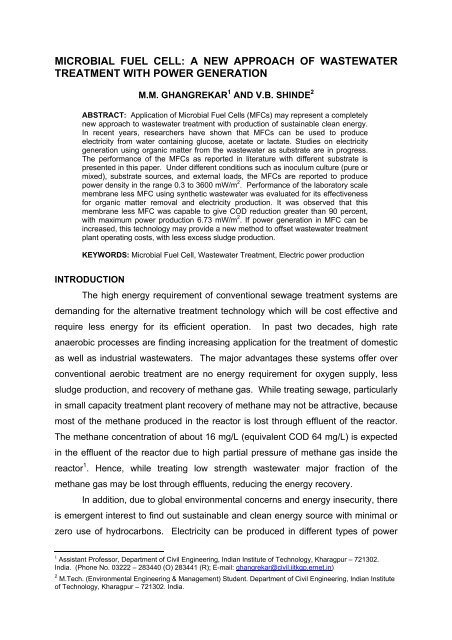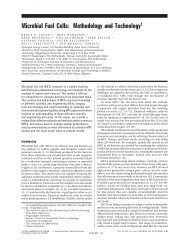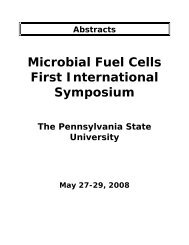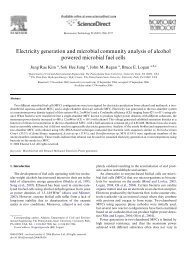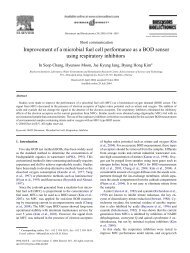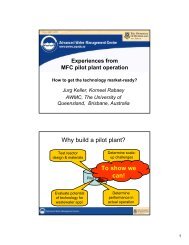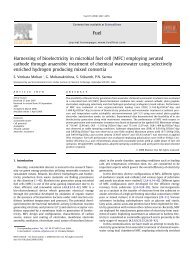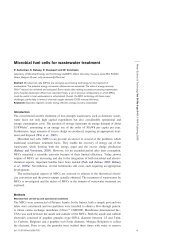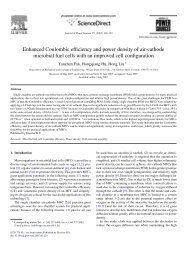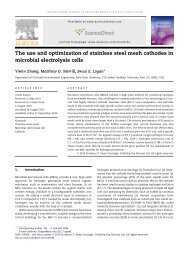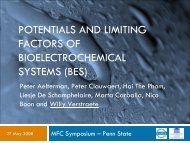Microbial fuel cell: a new approach of wastewater treatment
Microbial fuel cell: a new approach of wastewater treatment
Microbial fuel cell: a new approach of wastewater treatment
Create successful ePaper yourself
Turn your PDF publications into a flip-book with our unique Google optimized e-Paper software.
MICROBIAL FUEL CELL: A NEW APPROACH OF WASTEWATER<br />
TREATMENT WITH POWER GENERATION<br />
M.M. GHANGREKAR 1 AND V.B. SHINDE 2<br />
ABSTRACT: Application <strong>of</strong> <strong>Microbial</strong> Fuel Cells (MFCs) may represent a completely<br />
<strong>new</strong> <strong>approach</strong> to <strong>wastewater</strong> <strong>treatment</strong> with production <strong>of</strong> sustainable clean energy.<br />
In recent years, researchers have shown that MFCs can be used to produce<br />
electricity from water containing glucose, acetate or lactate. Studies on electricity<br />
generation using organic matter from the <strong>wastewater</strong> as substrate are in progress.<br />
The performance <strong>of</strong> the MFCs as reported in literature with different substrate is<br />
presented in this paper. Under different conditions such as inoculum culture (pure or<br />
mixed), substrate sources, and external loads, the MFCs are reported to produce<br />
power density in the range 0.3 to 3600 mW/m 2 . Performance <strong>of</strong> the laboratory scale<br />
membrane less MFC using synthetic <strong>wastewater</strong> was evaluated for its effectiveness<br />
for organic matter removal and electricity production. It was observed that this<br />
membrane less MFC was capable to give COD reduction greater than 90 percent,<br />
with maximum power production 6.73 mW/m 2 . If power generation in MFC can be<br />
increased, this technology may provide a <strong>new</strong> method to <strong>of</strong>fset <strong>wastewater</strong> <strong>treatment</strong><br />
plant operating costs, with less excess sludge production.<br />
KEYWORDS: <strong>Microbial</strong> Fuel Cell, Wastewater Treatment, Electric power production<br />
INTRODUCTION<br />
The high energy requirement <strong>of</strong> conventional sewage <strong>treatment</strong> systems are<br />
demanding for the alternative <strong>treatment</strong> technology which will be cost effective and<br />
require less energy for its efficient operation. In past two decades, high rate<br />
anaerobic processes are finding increasing application for the <strong>treatment</strong> <strong>of</strong> domestic<br />
as well as industrial <strong>wastewater</strong>s. The major advantages these systems <strong>of</strong>fer over<br />
conventional aerobic <strong>treatment</strong> are no energy requirement for oxygen supply, less<br />
sludge production, and recovery <strong>of</strong> methane gas. While treating sewage, particularly<br />
in small capacity <strong>treatment</strong> plant recovery <strong>of</strong> methane may not be attractive, because<br />
most <strong>of</strong> the methane produced in the reactor is lost through effluent <strong>of</strong> the reactor.<br />
The methane concentration <strong>of</strong> about 16 mg/L (equivalent COD 64 mg/L) is expected<br />
in the effluent <strong>of</strong> the reactor due to high partial pressure <strong>of</strong> methane gas inside the<br />
reactor 1 . Hence, while treating low strength <strong>wastewater</strong> major fraction <strong>of</strong> the<br />
methane gas may be lost through effluents, reducing the energy recovery.<br />
In addition, due to global environmental concerns and energy insecurity, there<br />
is emergent interest to find out sustainable and clean energy source with minimal or<br />
zero use <strong>of</strong> hydrocarbons. Electricity can be produced in different types <strong>of</strong> power<br />
1 Assistant Pr<strong>of</strong>essor, Department <strong>of</strong> Civil Engineering, Indian Institute <strong>of</strong> Technology, Kharagpur – 721302.<br />
India. (Phone No. 03222 – 283440 (O) 283441 (R); E-mail: ghangrekar@civil.iitkgp.ernet.in)<br />
2 M.Tech. (Environmental Engineering & Management) Student. Department <strong>of</strong> Civil Engineering, Indian Institute<br />
<strong>of</strong> Technology, Kharagpur – 721302. India.
plant systems, batteries or <strong>fuel</strong> <strong>cell</strong>s. Bacteria can be used to catalyze the<br />
conversion <strong>of</strong> organic matter into electricity 2,3,4,5,6,7 . Fuel <strong>cell</strong>s that use bacteria are<br />
classified as two different types: bio<strong>fuel</strong> <strong>cell</strong>s that generate electricity from the<br />
addition <strong>of</strong> artificial electron shuttles (mediators) and microbial <strong>fuel</strong> <strong>cell</strong>s (MFCs) that<br />
do not require the addition <strong>of</strong> mediator 8 . Unlike a battery, a <strong>fuel</strong> <strong>cell</strong> does not store<br />
energy. Instead, it converts energy from one form to another (much like an engine)<br />
and will continue to operate as long as <strong>fuel</strong> is fed to it. However, unlike internal<br />
combustion generators, <strong>fuel</strong> <strong>cell</strong>s convert chemical energy directly into electricity<br />
without an intermediate conversion into mechanical power. Fuel <strong>cell</strong>s, if used for<br />
<strong>wastewater</strong> <strong>treatment</strong>, can provide clean energy for people, apart from effective<br />
<strong>treatment</strong> <strong>of</strong> <strong>wastewater</strong>. The benefits <strong>of</strong> using <strong>fuel</strong> <strong>cell</strong>s include: clean, safe, quiet<br />
performance; high energy efficiency; low emissions; and ease in operating.<br />
Bio<strong>fuel</strong> <strong>cell</strong>s use biocatalysts for the conversion <strong>of</strong> chemical energy to<br />
electrical energy. It is a device that directly converts microbial metabolic or enzyme<br />
catalytic energy into electricity by using conventional electrochemical technology 2 .<br />
The biocatalysts participate in the electron transfer chain between the <strong>fuel</strong>-substrate<br />
(organic or inorganic) and the electrode surfaces 9 . That is, microorganisms or redoxenzymes<br />
facilitate the electron transfer between the <strong>fuel</strong> substrate and the electrode<br />
interface, thereby enhancing the <strong>cell</strong> current. It has been shown that, direct electron<br />
transfer from microbial <strong>cell</strong>s to electrodes occurs only at very low efficiency 10 . Most<br />
<strong>of</strong> the redox-enzymes lack in direct electron transfer with conductive supports and a<br />
variety <strong>of</strong> electron mediators (electron relays) are used for electrical contacting <strong>of</strong> the<br />
biocatalysts and the electrode. Since, most microbial <strong>cell</strong>s are electrochemically<br />
inactive; electron transfer from microbial <strong>cell</strong>s to the electrode is facilitated by the<br />
help <strong>of</strong> mediators such as thionine, methyl viologen, humic acid, etc. Enzyme<br />
catalyzed generation <strong>of</strong> NADH (dihydro-nicotinamide adenine dinucleotide) from<br />
alcohol, lactic acid, amino acids, formate or other abundant substrates could provide<br />
the bio-transformations that activate the anodic compartment <strong>of</strong> the <strong>fuel</strong> <strong>cell</strong> 9 .<br />
Theoretically, any organic or inorganic compound or a mixture can serve as a <strong>fuel</strong>,<br />
provided it is oxidized by the appropriate organism, e.g., the reaction for glucose is 11 :<br />
C 6 H 12 O 6 + 6H 2 O 6CO 2 + 24e - + 24 H + ….(1)<br />
Mediator Less MFC<br />
It has recently been shown that certain metal-reducing bacteria, belonging<br />
primarily to the family Geobacteraceae can directly transfer electrons to electrodes
using electrochemically active redox enzymes, such as cytochromes on their outer<br />
membrane 12,13 . These microbial <strong>fuel</strong> <strong>cell</strong>s does not need mediator for electron<br />
transfer to electrodes and are called as mediator less MFCs. Mediator less MFCs<br />
are considered to have more commercial application potential, because mediators<br />
used in Bio<strong>fuel</strong> <strong>cell</strong>s are expensive and can be toxic to the microorganisms 7 .<br />
The schematic diagram <strong>of</strong> mediator less MFC is shown in the Figure 1. In a<br />
MFC, two electrodes (anode and cathode) are placed in water in two compartments<br />
separated by a proton exchange membrane (PEM). Most studies have used<br />
electrodes <strong>of</strong> solid graphite 7 , graphite-felt 14 , carbon cloth 15 and platinum coated<br />
graphite cathode electrode 16 . Microbes in the anode compartment oxidize <strong>fuel</strong><br />
(electron donor) generating electrons and protons. Electrons are transferred to the<br />
cathode compartment through the external circuit, and the protons through the<br />
membrane. Electrons and protons are consumed in the cathode compartment<br />
reducing oxygen to water.<br />
Rate Limiting Steps: (1) Oxidation <strong>of</strong> Fuel, (2) Electron transfer from the microbial <strong>cell</strong>s to the<br />
electrode, (3) Electric load in the circuit, (4) Proton supply into the cathode compartment, (5) Oxygen<br />
supply and reduction at the cathode [Gil et al. 6 ].<br />
Figure 1: Mediator Less <strong>Microbial</strong> Fuel Cell with rate limiting steps<br />
In addition to microorganisms that can transfer electrons to the anode, the<br />
presence <strong>of</strong> other organisms appears to benefit MFC performance. It is reported<br />
that, a mixed culture generated a current that was six fold higher that that generated<br />
by a pure culture 17 . Hence, the microbial communities that develop in the anode<br />
chamber may have a similar function as those found in methanogenic anaerobic<br />
digesters, except that microorganisms that can transfer electrons to the electrode<br />
surface replace methanogens. Rabaey et al. 18 referred to such microbial<br />
communities as adapted anodophilic consortia. Anodophilic bacteria from different
evolutionary lineages from the families <strong>of</strong> Geobacteraceae, Desulfuromonaceae,<br />
Alteromonadaceae, Enterobacteriaceae, Pasteurellaceae, Clostridiaceae,<br />
Aeromonadaceae, and Comamonadaceae were able to transfer electrons to<br />
electrodes 19 . Methanogens also reported to have a capacity to transfer electrons 20 .<br />
Because the power output <strong>of</strong> MFCs is low relative to other types <strong>of</strong> <strong>fuel</strong> <strong>cell</strong>s,<br />
reducing their cost is essential, if power generation using this technology is to be an<br />
economical method <strong>of</strong> energy production. The overall limiting steps to enhance the<br />
power production are showed in the Figure 1. Further research is required to<br />
enhance the power production by overcoming these limitations. The main<br />
disadvantage <strong>of</strong> a two chamber MFC is that the solution cathode must be aerated to<br />
provide oxygen to the cathode 8 . The power output <strong>of</strong> an MFC can be improved by<br />
increasing the efficiency <strong>of</strong> the cathode, e.g. power is increased by adding<br />
ferricyanide to the cathode chamber 21 .<br />
The effects <strong>of</strong> operational conditions <strong>of</strong> a microbial <strong>fuel</strong> <strong>cell</strong> were investigated<br />
and optimized for the best performance <strong>of</strong> a mediator-less microbial <strong>fuel</strong> <strong>cell</strong> by Gil et<br />
al. 6 . The optimal pH reported was 7. The resistance higher than 500 Ω was the ratedetermining<br />
factor by limiting electron flow from anode to cathode. At the resistance<br />
lower than 200 Ω, proton and oxygen supplies to the cathode were limited. For the<br />
construction <strong>of</strong> an efficient microbial <strong>fuel</strong> <strong>cell</strong>, a non-compartmentalized <strong>fuel</strong> <strong>cell</strong> with<br />
an electrode having a high oxygen reducing activity should be developed. Since the<br />
concentration <strong>of</strong> <strong>fuel</strong> determines the amount <strong>of</strong> electricity generation from the <strong>fuel</strong><br />
<strong>cell</strong>, the device can be used as a BOD sensor.<br />
It is possible to design a MFC that does not require the cathodes to be placed<br />
in water. In hydrogen <strong>fuel</strong> <strong>cell</strong>s, the cathode is bonded directly to the PEM so that<br />
oxygen in air can directly react at the electrode 22 . This technique was successfully<br />
used to produce electricity from <strong>wastewater</strong> in a single chamber MFC 15 . However, a<br />
maximum <strong>of</strong> 788 mW/m 2 power density was reported by Park and Zeikus 21 with a<br />
Mn 4+ graphite anode and a direct air Fe 3+ graphite cathode.<br />
Membrane Less MFC<br />
In a meditor less MFC, the membrane separates the anode from the cathode<br />
as in other MFCs, and the membrane functions as an electrolyte that plays the role<br />
<strong>of</strong> an electric insulator and allows protons to move through 16 . However, the use <strong>of</strong><br />
membrane can limit the application <strong>of</strong> MFC to <strong>wastewater</strong> <strong>treatment</strong>. Proton transfer
through the membrane can be a rate limiting factor especially with fouling expected<br />
due to suspended solids and soluble contaminants in a large scale <strong>wastewater</strong><br />
<strong>treatment</strong> process. In addition, membranes are expensive and hence may limit its<br />
application. A membrane-less microbial <strong>fuel</strong> <strong>cell</strong> (ML-MFC) was developed by Jang<br />
et al. 16 and used successfully to enrich electrochemically active microbes that<br />
converted organic contaminants to electricity. The COD removal rate <strong>of</strong> 526.67 g/m 3<br />
day was reported with maximum power production 1.3 mW/m 2 and current density<br />
6.9 mA/m 2 . The design used in the study showed poor cathode reaction allowing a<br />
large quantity <strong>of</strong> oxygen to diffuse toward the anode. Further studies are required to<br />
improve the design <strong>of</strong> ML-MFC to improve current yield and COD removal efficiency.<br />
Power production <strong>of</strong> MFC and Further Development Required<br />
The major limitations to implementation <strong>of</strong> MFCs for <strong>treatment</strong> <strong>of</strong> <strong>wastewater</strong><br />
are their power density is still relatively low and the technology is only in the<br />
laboratory phase. Based on the potential difference, ∆E, between the electron donor<br />
and acceptor, a maximum potential <strong>of</strong> nearly 1 V can be expected in MFCs, which is<br />
not much greater than the 0.7 V that is currently being produced 21 . However, by<br />
linking several MFCs together, the voltage can be increased. Current and power<br />
densities are lower than what is theoretically possible, and system performance<br />
varies considerably as shown in Table 1. The maximum power density reported in<br />
the literature, 3600 mW/m 2 , was observed in a dual-chamber <strong>fuel</strong> <strong>cell</strong> treating<br />
glucose with an adapted anaerobic consortium in the anode chamber and a<br />
continuously aerated cathode chamber containing an electrolyte solution that was<br />
formulated to improve oxygen transfer to cathode 18 .<br />
Cost <strong>of</strong> the MFC can be minimized by using plain graphite electrodes without<br />
exogenous electron shuttles and a commercially available membrane 19 . Further<br />
improvement in the power density is required, and the rates <strong>of</strong> electron transfer to<br />
the anode are the major limiting factor. Optimization <strong>of</strong> MFCs is required, which<br />
involves investigation <strong>of</strong> a variety <strong>of</strong> aspects such as, anodophilic consortium<br />
selection for efficient electron transfer to electrode; cathode performance, oxygen<br />
supply and oxidation <strong>of</strong> <strong>fuel</strong>; MFC configuration, external resistance and electrodes<br />
(material and surface area); specific inoculum and concentration <strong>of</strong> bacteria; types <strong>of</strong><br />
organic material in the <strong>wastewater</strong>, and electron shuttles.
TABLE 1: POWER GENERATION RATES REPORTED IN THE LITERATURE 8<br />
Substrate Description Power (mW/m 2 )<br />
Complex Anaerobic sediments 16<br />
Starch <strong>wastewater</strong> 19<br />
Starch <strong>wastewater</strong> 20<br />
Domestic Wastewater 24<br />
Anaerobic sediments 28<br />
Domestic <strong>wastewater</strong>, CE-PEM 28<br />
Domestic <strong>wastewater</strong>, CE no PEM 146<br />
Defined Lactate 0.6 – 15<br />
Lactate, Peptone, and yeast extract 788<br />
Acetate (salt Bridge) 0.3<br />
Acetate 14 - 49<br />
Glucose 33 – 3600<br />
Glucose – CE-PEM 262<br />
Glucose – CE (no PEM) 494<br />
The basic disadvantages <strong>of</strong> microbial <strong>fuel</strong> <strong>cell</strong>s are their generally low<br />
coulombic yields and low power outputs. Many more improvements will be<br />
necessary, before biological <strong>fuel</strong> <strong>cell</strong> production and use can be commercialized. A<br />
membrane less MFC could improve the economic feasibility <strong>of</strong> the process to treat<br />
<strong>wastewater</strong> by reducing not only the capital investment, by eliminating costly<br />
membrane, but also the operational cost for the membrane maintenance. The<br />
objective <strong>of</strong> this study was to evaluate the electricity production potential and<br />
<strong>treatment</strong> efficiency <strong>of</strong> mediator less microbial <strong>fuel</strong> <strong>cell</strong> without membrane, using<br />
synthetic <strong>wastewater</strong> and mixed anaerobic microbial culture as inoculum.<br />
MATERIAL AND METHODS<br />
Membrane-less microbial <strong>fuel</strong> <strong>cell</strong><br />
Figure 2 shows the schematic diagram <strong>of</strong> the membrane-less microbial <strong>fuel</strong><br />
<strong>cell</strong> (ML-MFC) used in this study. The anode was at the bottom, and the cathode at<br />
the top <strong>of</strong> cylinder-shaped reactor made <strong>of</strong> polyacrylic having internal diameter <strong>of</strong> 10<br />
cm. Glass wool (4 cm depth) and glass bead (4 cm depth) was placed at the upper<br />
portion <strong>of</strong> the anode. Graphite rod, as roll form, was used for both anode and<br />
cathode. Total height <strong>of</strong> the reactor was 60 cm, and distance between the anode<br />
and cathode was 20 cm, including glass wool and glass bead. The apparent surface<br />
area <strong>of</strong> each anode and cathode was 46.65 cm 2 . The <strong>fuel</strong> was supplied to the bottom<br />
<strong>of</strong> the anode and the effluent left through the cathode compartment at the top. The<br />
electrodes were connected with copper wire through a resistance ranging from 10 Ω
to 100 Ω, including the resistance <strong>of</strong> copper wire and a multimeter. The internal<br />
resistance <strong>of</strong> the MFC was ranging from 3 MΩ to 4.5 MΩ.<br />
Figure 2: Membrane Less <strong>Microbial</strong> Fuel Cell used in the study<br />
Wastewater<br />
The <strong>wastewater</strong> was applied at the rate <strong>of</strong> 5.011 L/d making hydraulic<br />
retention time (HRT) in the MFC <strong>of</strong> 24 h. The cathode compartment was aerated at<br />
rate <strong>of</strong> 60 mL/min for the cathode reaction. A synthetic sewage containing sucrose<br />
as a carbon source was used throughout the study. The composition <strong>of</strong> the synthetic<br />
<strong>wastewater</strong> used is provided in Table 2. The COD <strong>of</strong> synthetic <strong>wastewater</strong> used was<br />
in the range 312 to 446 mg/l and influent pH was maintained in the range 7.2 to 7.6.<br />
TABLE 2: THE COMPOSITION OF THE SYNTHETIC WASTEWATER<br />
Component Sucrose NaHCO 3 NH 4 Cl K 2 HPO 4 KH 2 PO 4 CaCl 2 .2H 2 O MgSO 4 .7H 2 O<br />
mg/ L 300-450 480 95.5 10.5 5.25 63.1 19.2<br />
Note: Trace metals were added as FeSO 4 .7H 2 O = 10 mg/L, NiSO 4 .6H 2 O = 0.526 mg/l,<br />
MnSO 4 .H 2 O = 0.526 mg/l, ZnSO 4 .7H 2 O = 0.106 mg/l, H 3 BO 3 = 0.106 mg/l, CoCl 2 .6H 2 O = 52.6<br />
µg/L, CuSO 4 .5H 2 O = 4.5 µg/L, and (NH 4 ) 6 Mo 7 O 24 .4H 2 O = 52.6 µg/L.<br />
Enrichment <strong>of</strong> electrochemically active microbes for operating MFC<br />
The ML-MFC was inoculated with sludge (1.0 L) collected from septic tank<br />
bottom. All experiments were conducted at room temperature ranging from 29 to<br />
33 o C. For the first fifteen days <strong>of</strong> operation the MFC was operated without any<br />
pre<strong>treatment</strong> <strong>of</strong> the inoculum sludge. After fifteen days, the sludge form the MFC<br />
was removed, heated and inoculated. The sludge was heated at 100 o C for 15<br />
minutes to suppress the methanogens, cooled at room temperature and 1 L volume<br />
<strong>of</strong> sludge was added to the reactor in the anode compartment. No microbial addition<br />
was carried out in cathode compartment in both the cases.
Analyses<br />
The potential was measured using a digital multimeter (MASTECH M-830B,<br />
Russia) and converted to power according to P= iV, where P = power (W), i = current<br />
(A), and V = voltage (V). The influent and effluent characteristics such as, COD, pH,<br />
dissolve oxygen (DO), were monitored according to Standard Methods 23 .<br />
Biochemical oxygen demand (BOD) was determined for three days at 27 o C.<br />
RESULT AND DISCUSSION<br />
Enrichment<br />
The ML-MFC, inoculated with septic tank sludge, was operated on batch<br />
mode for first four days and from fifth day onward with continuous mode. The electric<br />
current production <strong>of</strong> 0.3 mA was observed at external load <strong>of</strong> 10 Ω for first five days<br />
<strong>of</strong> continuous operation, but latter gradual decrease in current production was<br />
observed and it was 0.1 mA after 15 days. This decrease could be attributed to the<br />
growth <strong>of</strong> methanogens in the anode chamber, reducing the availability <strong>of</strong> electron<br />
and proton, hence reducing current. The sludge from the anode chamber <strong>of</strong> MFC<br />
was heated at 100 ºC and re-inoculated. This method was found effective to obtain<br />
an enriched culture <strong>of</strong> hydrogen producers 24 . The current slowly increased for the<br />
first week, and it was 0.1 mA at external load <strong>of</strong> 100 Ω. The maximum current <strong>of</strong><br />
0.175 mA was observed at external load <strong>of</strong> 10 Ω with voltage 0.19 V. The open<br />
circuit potential was about 0.3 V after fifteen days <strong>of</strong> operation. Power density <strong>of</strong> 6.73<br />
mW/m 2 was observed in this experiment which is higher than the value 1.3 mW/m 2<br />
reported earlier 16 .<br />
COD Removal Efficiency<br />
The ML-MFC was operated at four different external resistance (10 to 100 Ω)<br />
and influent COD concentration ranging from 312 mg/l to 446 mg/l as presented in<br />
Table 3 and Figure 3. After 55 days <strong>of</strong> operation the COD and BOD removal<br />
efficiency <strong>of</strong> ML-MFC was 90.86% and 90.67%, respectively. The steady state<br />
condition for COD removal efficiency was observed after 55 days <strong>of</strong> operation with<br />
COD removal capacity <strong>of</strong> 0.406 kg/m 3 .d. The specific organic removal rate, with<br />
respect to anode chamber, <strong>of</strong> 0.08 kg COD/ kg VSS.d was observed. Studies are in<br />
progress to increase the loading capacity. The COD removal in the anode<br />
compartment was 46.36%. After achieving steady state, the effluent COD was 40.8<br />
mg/l and BOD 3 at 27 o C was 25 mg/L. These values demonstrate the capacity <strong>of</strong> ML-
MFC for <strong>wastewater</strong> <strong>treatment</strong>. The COD and BOD values reported are for unsettled<br />
effluent containing SS and VSS concentration <strong>of</strong> 40 mg/L and 6.2 mg/L, respectively.<br />
Further improvement in the effluent quality is expected by employing settling tank<br />
after MFC. The COD removal efficiency observed is on the higher side <strong>of</strong> the<br />
maximum efficiency reported in literature as 80 to 90 percent 15,16 . However, the<br />
organic loading rate as high as 27.02 kg COD/m 3 .d is reported with specific organic<br />
load as 18.63 kg glucose/ kg VSS.d for hydrogen production in CSTR type reactor 25 .<br />
TABLE 3: PERFORMANCE OF THE MEMBRANE LESS MICROBIAL FULE CELL<br />
A] COD AND BOD REMOVAL<br />
Days External<br />
Resistance<br />
(Ω)<br />
COD<br />
(Inlet)<br />
(mg/L)<br />
0-15 100 329.17<br />
(±45.43)<br />
16-35 10 399.90<br />
(±34.33)<br />
36-55 25 312.33<br />
(±16.74)<br />
56-78 50 446.50<br />
(±36.08)<br />
COD<br />
(middle)<br />
(mg/L)<br />
248.50<br />
(±19.09)<br />
312.30<br />
(±22.60)<br />
208.17<br />
(±55.53)<br />
239.50<br />
(±17.67)<br />
B] ELECTRICITY PRODUCTION<br />
COD<br />
(outlet)<br />
(mg/L)<br />
162.50<br />
(±24.74)<br />
72.4<br />
(±20.90)<br />
56.30<br />
(±11)<br />
40.8<br />
(±3.26)<br />
Efficiency<br />
(%)<br />
50.63<br />
BOD<br />
(Inlet)<br />
(mg/L)<br />
BOD<br />
(middle)<br />
(mg/L)<br />
BOD<br />
(outlet)<br />
(mg/L)<br />
DO<br />
(Inlet)<br />
(mg/L)<br />
DO<br />
(outlet)<br />
(mg/L)<br />
------ ------ ----- ----- ------<br />
81.89 280 175 48 5.4 4.33<br />
(±15) (±10) (±5) (±1.0) (±0.25)<br />
81.97 240 158 35 5.5 3.75<br />
(±20) (±12) (±5) (±1.0) (±0.35)<br />
90.86 268 162 25 5.4 4.14<br />
(±18) (±13) (±5) (±1.0) (±0.39)<br />
Days Current<br />
(mA)<br />
0-15 0.091<br />
(±0.011)<br />
16-35 0.175<br />
(±0.007)<br />
36-55 0.148<br />
(±0.007)<br />
56-78 0.121<br />
(±0.008)<br />
Voltage<br />
(V)<br />
0.116<br />
(±0.007)<br />
0.188<br />
(±0.003)<br />
0.175<br />
(±0.007)<br />
0.151<br />
(±0.005)<br />
Resistance Power<br />
(ohm) (mW/m 2 )<br />
100 2.29<br />
(±0.39)<br />
10 6.73<br />
(±0.44)<br />
25 5.46<br />
(±0.39)<br />
50 3.96<br />
(±0.46)<br />
Jule<br />
(J/d)<br />
HRT<br />
(hrs)<br />
0.92 24<br />
2.72 24<br />
2.20 24<br />
1.597 24<br />
Effect <strong>of</strong> External Resistance<br />
It was observed that at lower external resistance the current production is<br />
higher and vice versa. Even for same <strong>wastewater</strong> COD concentration the production<br />
<strong>of</strong> current is decreases due to increase in resistance shown in Figure 3. At same<br />
COD concentration when resistance was increased to 25 Ω and 50 Ω, the production<br />
<strong>of</strong> current decreased to 0.148 mA and 0.121 mA, respectively. These results show<br />
that the resistance becomes the rate-limiting step (step 3 in Figure 1). Even at lower<br />
resistance, low current production could be attributed to the lower electron<br />
consumption rate at the cathode than transfer rate from the external circuit. This<br />
might be due to limited supply <strong>of</strong> proton or oxygen (steps 4 and 5 in Figure 1). The
lower current production means that some electrons are consumed by mechanism(s)<br />
other than the cathode reaction. At this point it is not known how this is possible. It is<br />
plausible that under the conditions <strong>of</strong> limited electron disposal through the circuit with<br />
a high resistance, the electrons are consumed in the anode to reduce other electron<br />
acceptors such as sulfate and nitrate 6 , or oxygen diffused from cathode compartment<br />
or dissolved oxygen present in the influent. At low resistance the electrons move<br />
more easily through the external circuit than at high resistance, oxidizing electron<br />
carriers <strong>of</strong> the microbes in the anode. Higher <strong>fuel</strong> oxidation by the microbes is<br />
expected with high ratio <strong>of</strong> oxidized electron carriers <strong>of</strong> the culture at a low<br />
resistance to remove organic contaminants at a high rate 16 .<br />
Influent COD, mg/L<br />
COD at outlet <strong>of</strong> anode chamber, mg/L<br />
0.25<br />
600<br />
Efflent COD, mg/L<br />
Current,mA<br />
Resistance, Ohm<br />
Voltage, V<br />
0.23<br />
COD (mg/L) & Resistance (ohm)<br />
500<br />
400<br />
300<br />
200<br />
100<br />
0.21<br />
0.19<br />
0.17<br />
0.15<br />
0.13<br />
0.11<br />
0.09<br />
0.07<br />
Current (mA), Voltage (V)<br />
0<br />
0.05<br />
0 20 40 60 80<br />
Time (days)<br />
Figure 3. Time course <strong>of</strong> performance <strong>of</strong> membrane less microbial <strong>fuel</strong> <strong>cell</strong><br />
Effect <strong>of</strong> Dissolved oxygen monitoring <strong>of</strong> cathode compartment<br />
The microbial <strong>cell</strong> was operated with aeration in the cathode compartment.<br />
The current and DO concentration measured under different external load are<br />
provided in Table 3. When the cathode compartment was aerated, the current<br />
increased sharply, and so did DO slowly. When the aeration was stopped the current<br />
decreased, whilst the decrease in DO was less significant. These results show that<br />
DO is the major limiting factor for the operation <strong>of</strong> a microbial <strong>fuel</strong> <strong>cell</strong> with graphite<br />
electrode. Probably, due to poor catalytic activity <strong>of</strong> graphite to reduce oxygen, which<br />
can be explained better by analyzing proton compensation in cathode chamber 6 .
CONCLUSIONS<br />
Under present investigation, the membrane less MFC was used effectively for<br />
synthetic <strong>wastewater</strong> <strong>treatment</strong> with COD and BOD removal about 90%. The power<br />
production <strong>of</strong> this MFC observed was 6.73 mW/m 2 . If power generation in these<br />
systems can be increased, MFC technology may provide a <strong>new</strong> method to <strong>of</strong>fset<br />
<strong>wastewater</strong> <strong>treatment</strong> plant operating cost, making <strong>wastewater</strong> <strong>treatment</strong> more<br />
affordable for developing and developed nations. The possibility <strong>of</strong> direct conversion<br />
<strong>of</strong> organic material in <strong>wastewater</strong> to bio-electricity is exciting, but fundamental<br />
understanding <strong>of</strong> the microbiology and further development <strong>of</strong> technology is required.<br />
With continuous improvements in microbial <strong>fuel</strong> <strong>cell</strong>, it may be possible to<br />
increase power generation rates and lower their production and operating cost.<br />
Thus, the combination <strong>of</strong> <strong>wastewater</strong> <strong>treatment</strong> along with electricity production may<br />
help in saving <strong>of</strong> millions <strong>of</strong> rupees as a cost <strong>of</strong> <strong>wastewater</strong> <strong>treatment</strong> at present.<br />
ACKNOWLEDGEMENT<br />
The grants provided by University Grants Commission, New Delhi (F. No. 14-10/2003 (SR)) under the<br />
head Major Research Project, to undertake this research work, are duly acknowledged.<br />
REFERENCES<br />
1. Haandel van Adrianus C. and Gatz Lettinga (1994). Anaerobic Sewage Treatment, John Wiley &<br />
Sons, Singapore.<br />
2. Allen R.M., Bennetto H.P.. (1993). <strong>Microbial</strong> <strong>fuel</strong> <strong>cell</strong>s: electricity production from carbohydrates.<br />
Appl Biochem Biotechnol, 39-40:27-40.<br />
3. Wingard L.B., Shaw C.H., Castner J.F.. (1982). Bioelectrochemical <strong>fuel</strong> <strong>cell</strong>s. Enzyme Microb.<br />
Technol., 4:137-142.<br />
4. Reimers C.E., Tender L.M., Ferig S, Wang W. (2001). Harvesting energy from the marine<br />
sediment-water interface. Environ. Sci. Technol., 35:192-195.<br />
5. Kim H.J., Park H.S., Hyun M.S., Chang I.S., Kim M, Kim B.H. (2002). A mediator-less microbial<br />
<strong>fuel</strong> <strong>cell</strong> using a metal reducing bacterium, Shewanella putrefaciens. Enzyme. Microb. Technol.,<br />
30:145-152.<br />
6. Gil G.C., Chang I.S., Kim B.H., Kim M, Jang J.K., Park H.S., Kim H.J. (2003). Operational<br />
parameters affecting the performance <strong>of</strong> a mediator-less microbial <strong>fuel</strong> <strong>cell</strong>. Biosens. Bioelectron.<br />
18:327-334.<br />
7. Bond D.R., and Lovley D.R. (2003). Electricity production by Geobacter sulfurreducens attached<br />
to electrodes. App. Environ. Microbiol., 69:1548-1555.<br />
8. Liu H, and Logan B.E. (2004). Electricity generation using an air-cathode single chamber<br />
microbial <strong>fuel</strong> <strong>cell</strong> in the presence and absence <strong>of</strong> a proton exchange membrane. Environ. Sci.<br />
Technol., 38(14):4040-4046.
9. Williner I, Arad G, Katz E. (1998). A bio<strong>fuel</strong> <strong>cell</strong> based on pyrroloquinoline quinine and<br />
microperoxidase-11 monolayer-functionalized electrodes. Bioelectrochem. Bioenerg., 44:209-214.<br />
10. Allen M.J. (1972). Cellular electrophysiology. In Norris J.R. and Ribbons D.W. Methods in<br />
microbiology. Academic Press, New York, N. Y. p.247-283.<br />
11. Kosaric N and Velikonja J., (1995). Liquid and gaseous <strong>fuel</strong>s from biotechnology: challenge and<br />
Opportunities. FEMS Microbiology Reviews 16: 111-142.<br />
12. Kaufmann F. and Lovely R. (2001). Isolation and characterization <strong>of</strong> a soluble NADPHindependent<br />
Fe(III) reductase from geobacteria sulphur reducens. J. Bacteriol. 185:15: 4468-<br />
4476.<br />
13. Magnuson T.S., Hodges Myerson A.L., Lovely D.R. (2000). Characterization <strong>of</strong> the membranebound<br />
NADH-dependent Fe(III) reductase from the dissmilatory Fe(III)-reducing bacterium<br />
geobacteria sulphur reducens. FEMS <strong>Microbial</strong> Letter, 185:205-211.<br />
14. Chaudhuri S.K., Lovely D.R. (2003). Electricity generation by direct oxidation <strong>of</strong> glucose in<br />
mediatorless microbial <strong>fuel</strong> <strong>cell</strong>s. Nat. Biotechnol. 21(10):1129-1232.<br />
15. Liu H, Ramnarayanan R, Logan B. (2004). Production <strong>of</strong> electricity during <strong>wastewater</strong> <strong>treatment</strong><br />
using a single chamber microbial <strong>fuel</strong> <strong>cell</strong>. Environ. Sci. Technol., 38:2281-2285.<br />
16. Jang J.K., Pham T.H., Chang I.S., Kang K.H., Moon H, Cho K.S., Kim B.H. (2004). Construction<br />
and operation <strong>of</strong> a novel mediator-and membrane-less microbial <strong>fuel</strong> <strong>cell</strong>. Process Biochem.<br />
39:1007-1012.<br />
17. Park D.H. and Zeikus J.G. (2002). Impact <strong>of</strong> electrode composition on electricity generation in a<br />
single-compartment <strong>fuel</strong> <strong>cell</strong> using Shewanella putrefaciens. Appl. Microbiol. Biotechnol., 59:58-<br />
61.<br />
18. Rabaey K, Lissens G, Siciliano S.D., Verstraete W. (2003). A microbial <strong>fuel</strong> <strong>cell</strong> capable <strong>of</strong><br />
converting glucose to electricity at high rate and efficiency. Biotechnol. Lett., 25:1531-1535.<br />
19. Angenent L.T., Karim K., Al-Dahhal N.H., Wrenn B.A., Domiguez Espinosa R. (2004). Production<br />
<strong>of</strong> bioenergy and biochemicals from industrial and agricultural <strong>wastewater</strong>. Trends in<br />
Biotechnology, 22:9:477-485.<br />
20. Sawyer C.N., McCarty P.L., Parkin. (1994). Chemistry for environmental engineering. McGraw-<br />
Hill Book Co., Singapore.<br />
21. Park D.H., Zeikus J.G. (2003). Improved <strong>fuel</strong> <strong>cell</strong> and electrode design for production electricity<br />
from microbial degradation. Biotechnol. Bioeng., 81(3): 348-355.<br />
22. Gottesfeld S. and Zawodzinski T.A. (1997). Polymer electrolyte <strong>fuel</strong> <strong>cell</strong>. Adv. Electrochem. Sci.,<br />
5:195-301.<br />
23. APHA, AWWA, WPCF, (1998). Standard Methods for examination <strong>of</strong> water and <strong>wastewater</strong>. 20th<br />
Edition, American Public Health Association, Washington, DC.<br />
24. Ginkel S.V., Sung S., Lay J-J. (2001). Biohydrogen production as a function <strong>of</strong> pH and substrate<br />
concentration. Env. Sci. & Terchnol. 35: 4726-4730.<br />
25. Mizuno Osamu, Dinsdale Richard, Hawkes F.R., Hawkes D.L., Noike Tatsuya, Enhancement <strong>of</strong><br />
Hydrogen Production from Glucose by Nitrogen gas sparging. Bioresources Technology, 2000:<br />
73, 59-65.


